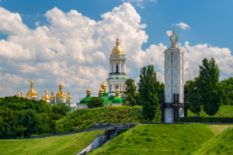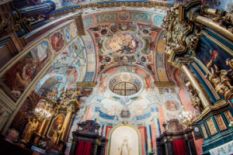In 2013, a joint cluster of eight Ukrainian wooden churches located in the Carpathians was included in UNESCO World Heritage Sites. It's interesting to note that UNESCO uses the Ukrainian word for church, Tserkva, to emphasize the cultural significance. The landmarks are said to have 'exceptional testimony to a distinct ecclesiastical building tradition' and 'represent an important historical stage of architectural design in the Carpathian Region'.
The architecture of the wooden temples might be unusual for other regions of Ukraine but for the Carpathian Lemkos and Boikos, it's a typical sight. The churches are built on a tri-partite plan surmounted by open quadrilateral or octagonal domes and cupolas. The interior is centered around iconostasis that is usually luxuriously decorated. The churches typically are built on or near the graveyard that allows serving liturgies for the deceased. Another prominent feature is a bell tower that is traditionally included in the plan of temples. Sure enough, each of the eight churches still has its peculiarities.
The Church of the Descent of the Holy Spirit, Rohatyn
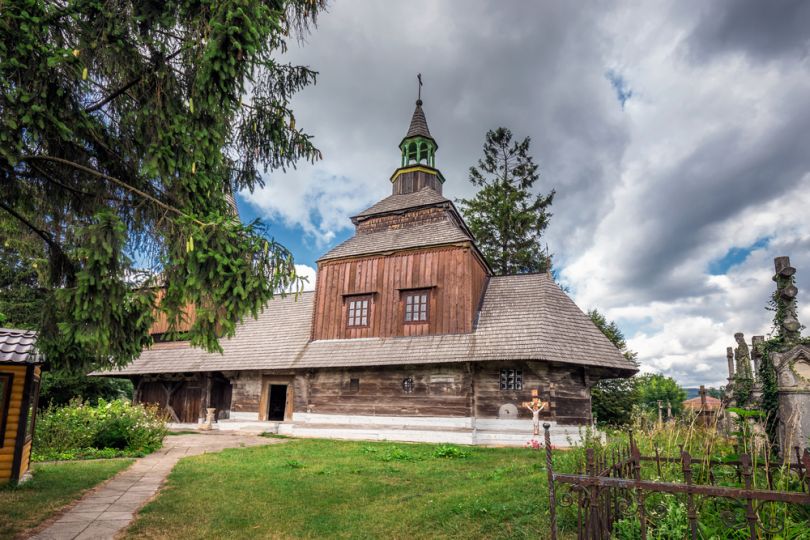 This church with strict lines and towers is quite unique even on UNESCO list - it's the oldest existing wooden church in Ukraine. The first written mentioning of the church dates back to 1481 in a State Archive of Lviv, however, officially the church is dated 1598 - the year carved on one of the church walls.
This church with strict lines and towers is quite unique even on UNESCO list - it's the oldest existing wooden church in Ukraine. The first written mentioning of the church dates back to 1481 in a State Archive of Lviv, however, officially the church is dated 1598 - the year carved on one of the church walls.
The church was a place of worship for one of the first Orthodox Brotherhoods in Ukraine, Rohatyn Brotherhood. They were the ones who ordered a luxurious Baroque iconostasis - completed in 1650, it belongs to the three oldest iconostases in Ukraine. The church of the Descent of the Holy Spirit was lucky to survive numerous regimes and two World Wars with minor renovations. Nowadays it functions as a museum and hosts an exhibition of traditional Galician icons, sculptures and carving.
The Church of the Holy Trinity, Zhovkva
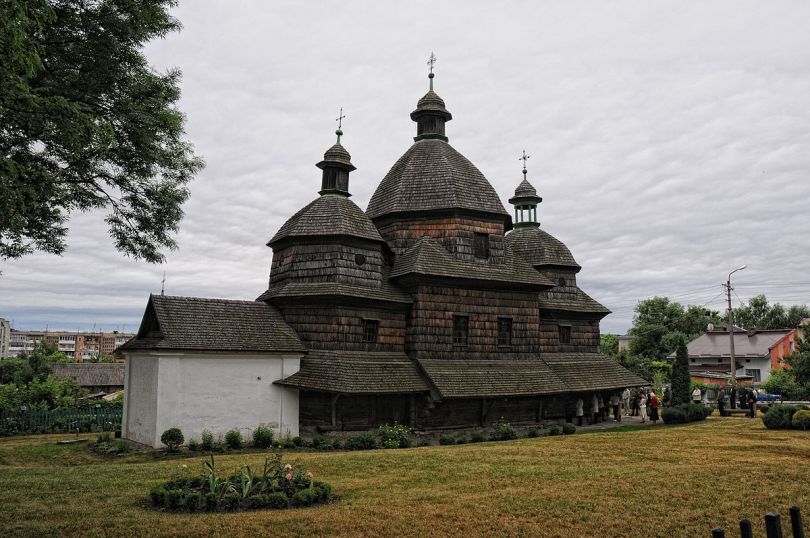 The Church of the Holy Trinity in Zhovkva in the West of Ukraine is another example of wooden architecture landed on UNESCO World Heritage Site list. The Holy Trinity church was first erected at the beginning of the 17th century in 1601 but the great Lviv fire of 1719 burned the wooden construction to the ground.
The Church of the Holy Trinity in Zhovkva in the West of Ukraine is another example of wooden architecture landed on UNESCO World Heritage Site list. The Holy Trinity church was first erected at the beginning of the 17th century in 1601 but the great Lviv fire of 1719 burned the wooden construction to the ground.
The new church was built in 1720 in the Renaissance style. The Holy Trinity in Zhovkva is famous for its iconostasis - it features about 50 works made by the famous icon painter Ivan Rutkovych at the beginning of the 18th century. The church was closed during the early Soviet era, then opened as a museum, renovated in the 1970s and nowadays it belongs to the Ukrainian Greek Catholic Church.
The Church of Our Lord’s Ascension, Yasinia
 The Church of Our Lord’s Ascension in Yasinia is also often called Strukivska Tserkva. The reason lies behind a local legend - a shepherd called Ivan Struk built a church in gratitude to God for saving the sheep during the harsh winter. The exact date of construction is unknown and the church hasn’t survived to the present day. The new church was erected on the place of the old one in 1824.
The Church of Our Lord’s Ascension in Yasinia is also often called Strukivska Tserkva. The reason lies behind a local legend - a shepherd called Ivan Struk built a church in gratitude to God for saving the sheep during the harsh winter. The exact date of construction is unknown and the church hasn’t survived to the present day. The new church was erected on the place of the old one in 1824.
It is located on the right bank of the Chrorna Tysa river, so to get to the church, you need to cross the picturesque suspension bridge. The Hutsul sacred temple saved the iconostasis dating back to the church construction era. However, according to the tourists, it wasn't professionally restored. Nowadays the Church of Our Lord’s Ascension is also a point of interest among philatelists - the wooden temple appears on the rare 1939 Czechoslovakian stamp issued to commemorate the Act of independence of the Carpathian Ukraine.
The Church of the Synaxis of the Blessed Virgin Mary, Matkiv
The Church of the Synaxis of the Blessed Virgin Mary was built in 1838 in a small Matkiv village. It is often considered one of the finest examples of Ukrainian Boiko architecture, reflecting the traditions of the Carpathian highlanders. The church is located on a small hill in the central part of the city in the valley of the Stryi River. Its main western entrance bears several inscriptions: "Tey swiatyni fundamenta" ("This is a fundament of a temple"), "Zalozone dnia 21 czerw." ("The foundation laid on June 21"), "Roku 1838" ("In 1838").
The interior boasts the 19th-century murals. Like many Ukrainian wooden churches, the Church of the Synaxis of the Blessed Virgin Mary has a bell tower - it is located in the southwest of the church. The bell tower is also wooden and has a balcony on the second tier, facing towards a small square in front of the southern facade of the church. It was built later than the church - in 1924. Nowadays the church works according to its original function and is sometimes called the Church of Saint Dmytro.
The Сhurch of the Nativity of the Blessed Virgin Mary, Nyzhniy Verbizh
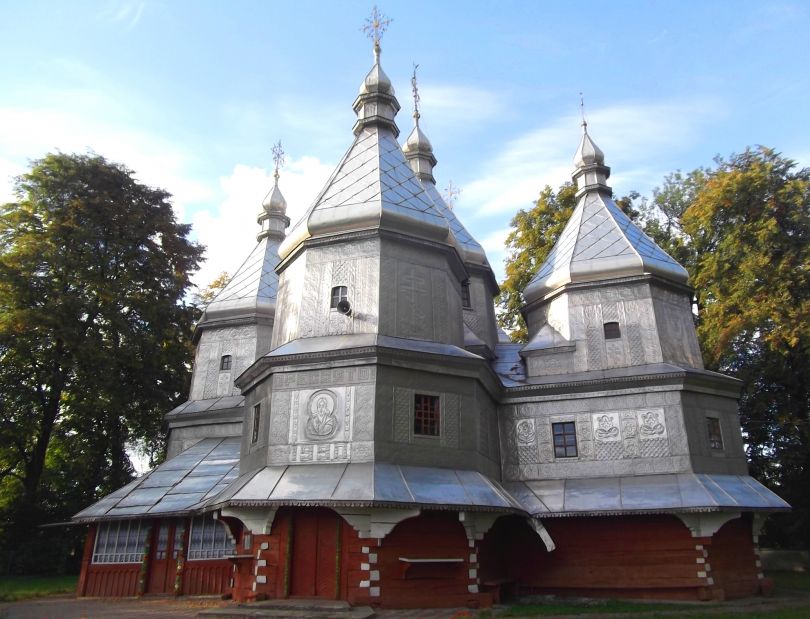 The Сhurch of the Nativity of the Blessed Virgin Mary safekeeps various versions and legends concerning its construction in the Nyzhniy Verbizh village. According to the popular version, it was built in 1756–1808 by Hryhir Melnyk sponsored by the folk uprising members opryshky. Hryhir lived a long life of 114 years and was buried on the graveyard of that very church.
The Сhurch of the Nativity of the Blessed Virgin Mary safekeeps various versions and legends concerning its construction in the Nyzhniy Verbizh village. According to the popular version, it was built in 1756–1808 by Hryhir Melnyk sponsored by the folk uprising members opryshky. Hryhir lived a long life of 114 years and was buried on the graveyard of that very church.
An information stand near the Сhurch of the Nativity of the Blessed Virgin Mary states that on this place once stood a men's monastery burned to the ground during the Tatar-Mongol invasion. The truth, as always, is somewhere in the middle. Nowadays, the wooden church works according to its purpose. It is located on the west of the village. Nyzhniy Verbizh village is situated near Kolomiya that too has numerous intriguing landmarks.
The Church of Saint George, Drohobych
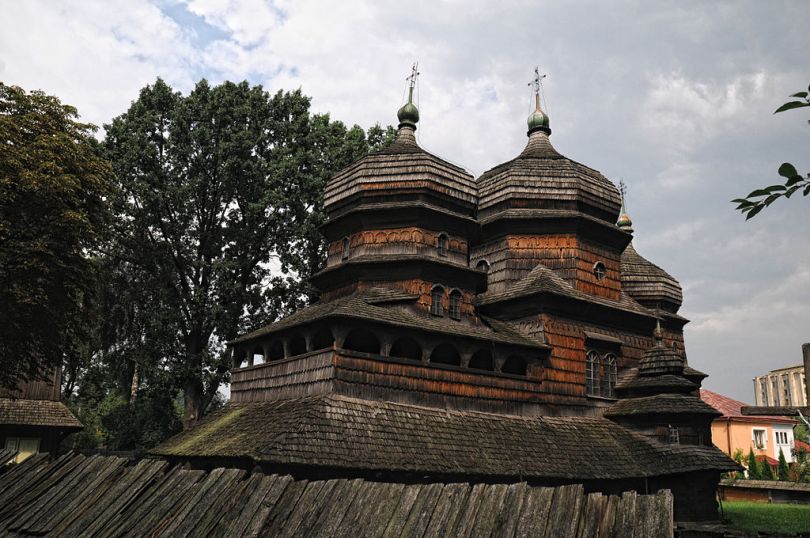 The Church of Saint George in Drohobych is one of the most well-preserved monuments of Halytch wooden architecture of the 15-16th centuries. The construction of the Church of Saint George is debated in various sources. According to the most popular version, it was erected in the 15th century and the construction was finished in 1678. Tourist guides often state that the church was moved from the Carpathian village Nadiiv in 1656.
The Church of Saint George in Drohobych is one of the most well-preserved monuments of Halytch wooden architecture of the 15-16th centuries. The construction of the Church of Saint George is debated in various sources. According to the most popular version, it was erected in the 15th century and the construction was finished in 1678. Tourist guides often state that the church was moved from the Carpathian village Nadiiv in 1656.
It's interesting that apart from its architectural importance, this church has also witnessed Ukrainian history. In July 1941, locals pledged allegiance to Ukraine after hearing the news about the proclamation of Act of Restoration of the Ukrainian state that took place in the Nazi-occupied Lviv. Nowadays the church is a part of the Drohobychyna museum.
The Church of the Descent of the Holy Spirit, Potelych
The Church of the Descent of the Holy Spirit in the Potelych village is the oldest wooden church of the Lviv region. Constructed in 1502, it is also the oldest threefold in the whole entity of Ukraine. It was built on the place of a former church of Saint Borys and Glib burned during the Tatar-Mongol invasion. Legends state that Hetman Bohdan Khmelnytsky once attended the service in this church.
The wooden temple in Potelych has a prominent two-level iconostasis installed in the 17th century. One of its icons, Deesis, was completed by the famous icon-writer Ivan Rutkovych, who shaped the style of the 17th-century western Ukrainian icon writing tradition. Besides, colorful murals on the walls date back to the 1620s. Nowadays the church regularly holds services.
The Сhurch of the Synaxis of the Archangel Michael, Uzhok
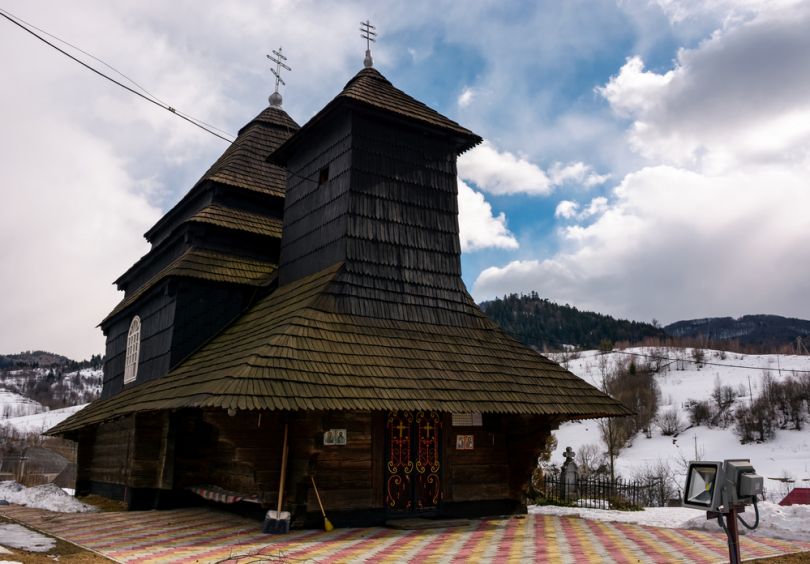 Finally, the last among the wooden Ukrainian churches on UNESCO World Heritage Site list is the Сhurch of the Synaxis of the Archangel Michael. The simple dark construction in the Uzhok village belongs to the examples of Boiko style architecture. It was constructed in 1745. According to the legends, it was initially built on the high hill but it was tough for the elders to visit the church. That's why the temple was moved lower down the hill.
Finally, the last among the wooden Ukrainian churches on UNESCO World Heritage Site list is the Сhurch of the Synaxis of the Archangel Michael. The simple dark construction in the Uzhok village belongs to the examples of Boiko style architecture. It was constructed in 1745. According to the legends, it was initially built on the high hill but it was tough for the elders to visit the church. That's why the temple was moved lower down the hill.
The three-folding church reminds of a hill with three small tops. The Сhurch of the Synaxis of the Archangel Michael is often praised as being complementing, not contrasting the local nature. Unfortunately, the interior of the church was unprofessionally restored and the original 17th-century icons were roughly rewritten by amateur painters.
Sources: whc.unesco.org, decerkva.org.ua, zakarpattya.net.ua.
Photo sources: Сергій Криниця (Haidamac), Okosmin, Валерій Ящишин, Тарас Возняк, Андрій Банний / uk.wikipedia.org, depositphotos.com. All images belong to their rightful authors.
